Why does the trailing edge of the wings of some sub-adult Bald Eagles in flight have an irregular appearance rather than the “straight-cut” look of most other eagles?
This is an older series I’ve never posted before, largely because the background in many of the photos is very close to the eagle and some viewers will probably find it distracting. But I like the flight postures and I think the sub-adult eagle has some interesting white mottling so I decided to go against my better? instincts and post it anyway.
Besides, I see a “teachable moment” in the series and you know how I am about that kind of thing…
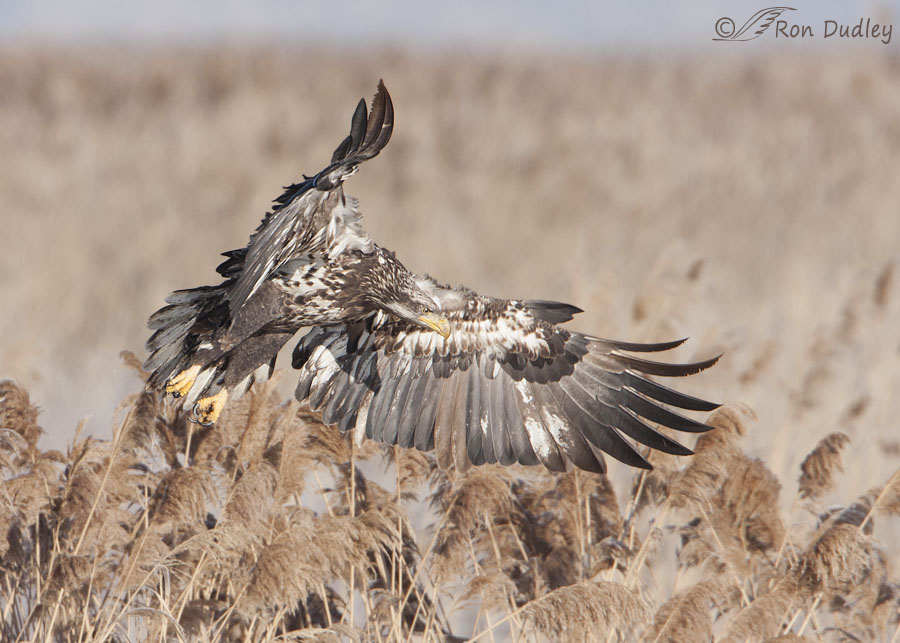
1/1600, f/8, ISO 500, Canon 40D, Canon EF 500mm f/4L IS USM + EF 1.4 III Extender, not baited, set up or called in
It was a typical very cold but sunny winter day at Farmington when I caught the immature eagle coming in to land near the shore of one of the ponds. This shot has the least distracting background of the series because the bird is above most of the closest phragmites. I actually like the layered background of pale blue sky, out of focus phrags in the middle background and sharper phrag plumes below.
Sharp eyes will likely notice that three of the secondary flight feathers on the left wing are significantly longer than the others. Juvenile secondaries are longer that those of sub-adults and adults so those three feathers are faded juvenile feathers that have yet to be molted. The resulting irregular appearance of the trailing edge of the wings is a useful field mark for estimating relative age of sub-adult Bald Eagles in flight.
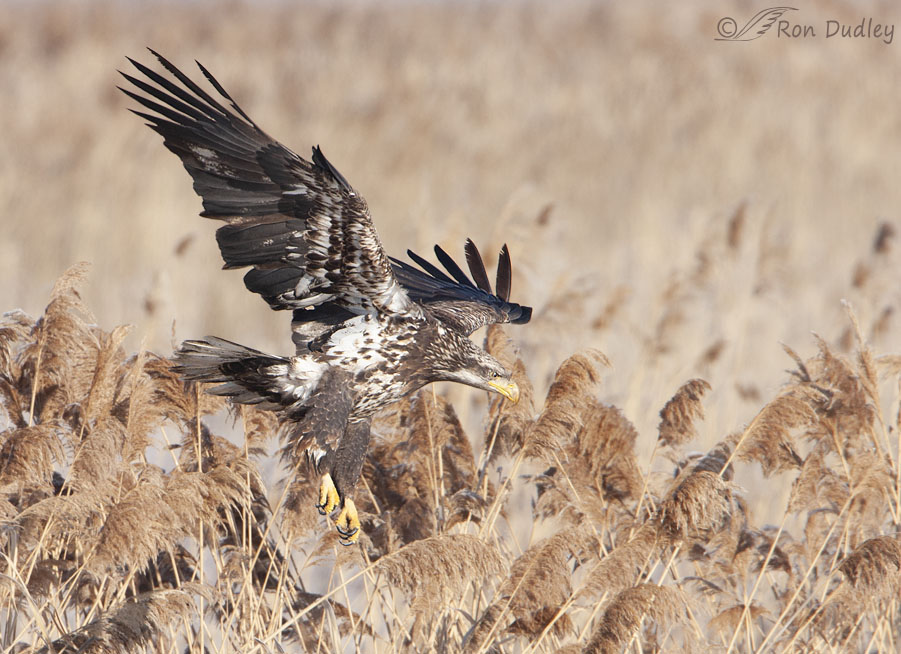
1/1600, f/8, ISO 500, Canon 40D, Canon EF 500mm f/4L IS USM + EF 1.4 III Extender, not baited, set up or called in
The right wing has also retained some of those longer juvenile secondaries but they’re less obvious in this photo.
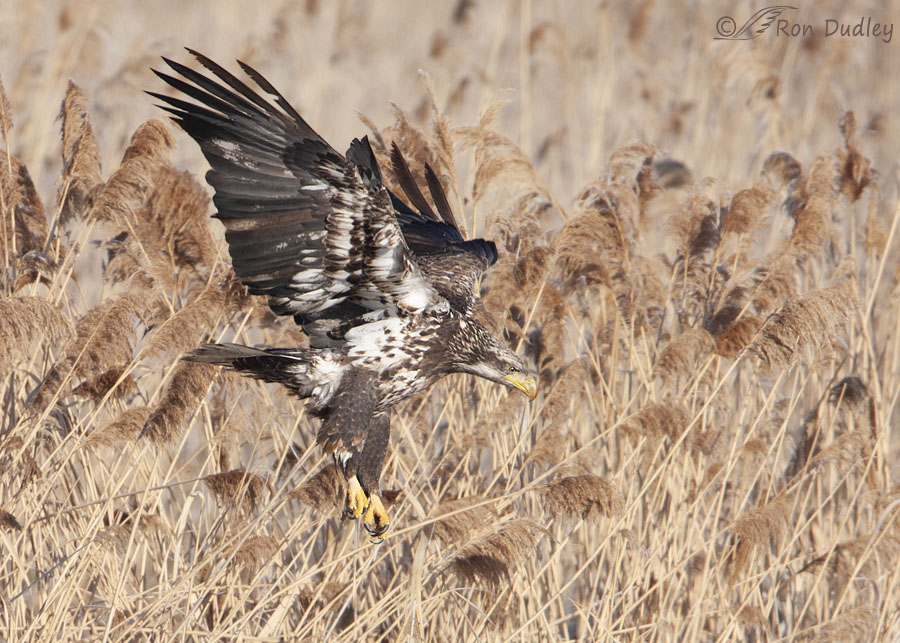
1/1600, f/8, ISO 500, Canon 40D, Canon EF 500mm f/4L IS USM + EF 1.4 III Extender, not baited, set up or called in
By now the eagle is very close to the closest phrags.
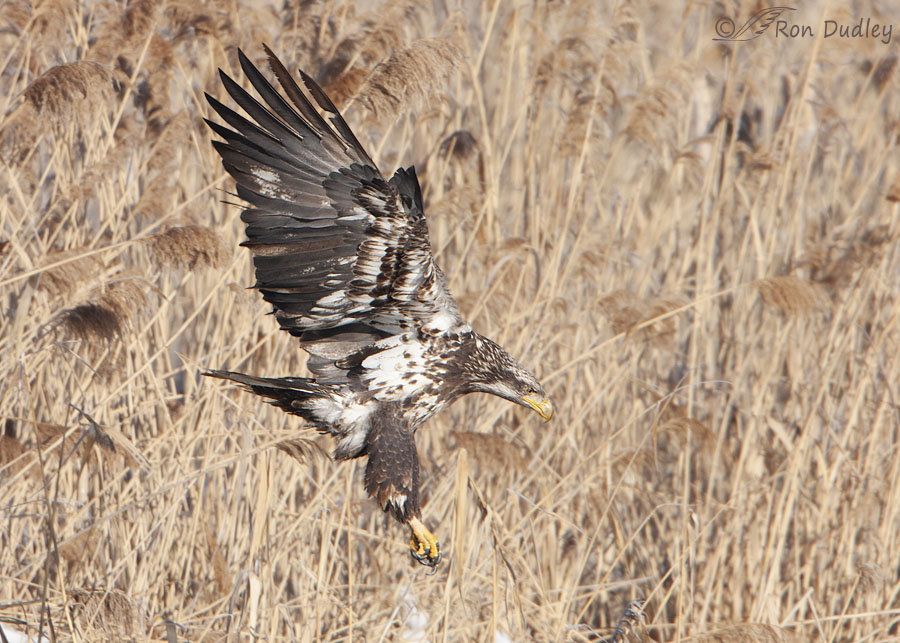
1/1600, f/8, ISO 500, Canon 40D, Canon EF 500mm f/4L IS USM + EF 1.4 III Extender, not baited, set up or called in
And now the bird is low enough that we actually see some of the snow on the ground. This is the last photo I’m including in the series because I didn’t like the actual landing shots very well.
Ok, I’ll admit another reason I posted this series. It was taken over ten years ago and until last night I hadn’t seen it for years. I’m more than a little surprised that back then I was able to keep focus locked on the eagle with the background so close to the bird. In 2009 I was far from a skilled bird photographer and typically in a situation like this the close background would grab my active focus points and the bird would be soft.
It must have been my lucky day.
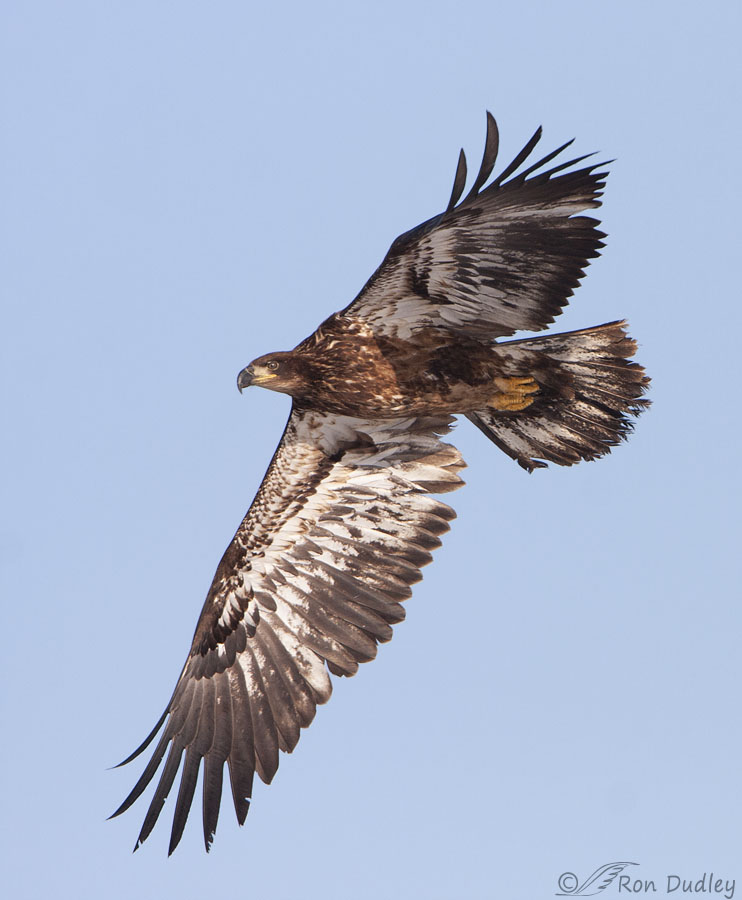
1/2000, f/8, ISO 500, Canon 40D, Canon EF 500mm f/4L IS USM + EF 1.4 III Extender, not baited, set up or called in
This photo of a juvenile (1st year) Bald Eagle was taken at Farmington on the same day.
I’m including it for two reasons – to give my readers a visual break from the busier background of the earlier series (backgrounds don’t come much cleaner than plain blue sky) and to illustrate the “straight cut” trailing edge of the wing of the juvenile as compared to the more irregular appearance of the sub-adult in the earlier series.
Ron
Note: I don’t claim to be an expert on the age progression of Bald Eagles. I’m only reporting here what I’ve learned from folks much smarter than myself and it’s always possible that I’ve misinterpreted some of the information or used some technically incorrect terminology (the preferred application of “juvenile” and “sub-adult” for example). It can be confusing so if I’ve made any errors please let me know and I’ll correct them.
I sure as hell don’t want to join the long list of perveyors of “False News”…


Ron, I like your shots, particularly the last one…what a grand looking bird. As always, I appreciate your narrative along with your readers. There is a lot to be learned.
Thank you, Ron
There sure is. Thank you, Alice.
Fabulous shots from your archives — you may need to go fishing there more often. 😉 Thanks to all for the info about the juvenile vs. subadult flight feathers. Fascinating.
By coincidence, the Perry Mason episode that has just finished had its crime solved in part because of a nature photographer! 😀
Thank you, Marty.
Perry Mason!? Some version of that show is still alive and kicking or been brought back from the dead? Goes to show how much TV I watch. Almost none…
We have a couple of “classic tv” channels n SoCal. I get to relive some of my childhood and occasionally see my uncle.
As always HUGE thanks to you and to your knowledgeable commentators. Starting my day learning AND with eye candy is always welcome.
Thank you, EC.
Some folks call all the eagles without white heads “juvies.” Here in Florida they hatch out in January and they certainly are larger than the adults when they take their first flight– maybe an extra inch or more of tail and wing feathers. Their secondaries seem especially longer and cause a noticeable bulge as compared to adults. When they start replacing with shorter adult feathers they do look a bit ragged but should no longer be called juveniles, as they are second year immature birds. Also, they get mostly white heads around their fifth year, after they are four (not 5) years old. In between I’m with you as there is a lot of room for confusion about ages.
Ken, I think part of that confusion you mention is because there’s so much variation in plumage even at the same age.
Enjoyable series.you are the best bird photographer
Out there not to mention the knowledge you possess. Stunning stuff!
Thank you for the very kind words, Linda.
Nice series. I’m glad you brought them forward. You know that I am also a sucker for a “teachable moment.” May I chime in?
Becoming an adult raptor is not easy. Approximately 70% of young birds never survive ro complete their first year. There’s a lot to learn in a very short time and without well-developed hunting skills, your chances of survival quickly diminish. As Laura pointed out, the feathers can take quite a beating during unsuccessful hunting attempts as young birds are leaning. But you might see more of this “raggedness” on young Bald Eagles than on most other raptors. Unlike the majority of raptors, Bald Eagles have a first-year survival rate that is close to 50%. Far greater than most species. I suspect that this may be partly due to a much more varied diet (fish, carrion, mammals, etc.) Because they are more successful at surviving that first year, we have more opportunity to see some of these ragged conditions. If capture of prey doesn’t go well one day, carrion works fine as food for them, and it certainly doesn’t require capturing skills (just fighting off the other eagles, young and adults, who might wish to steal it from you. And letting others (especially Osprey) do the actual hunting before you steal it from them also helps keep your feathers less damaged. Even so, the wear on the feather edges is considerable and we see evidence of that as in your photos.
You’re always welcome to chime in, Dan.
I was unaware that the survival rate of juvenile Bald Eagles was that much higher than the survival rate of other raptor species.
VERY interesting! 🙂
That IS interesting on the feather lengths…… 🙂 The sure do look “ratty” during the transition! Mostly watching from down here in the “hole” I see them from below and silhouetted. I have noticed the feather length difference at times – just figured they were damaged…… Always something to learn! 🙂
Thank you, Judy.
Of course, you’re right about the aging issue of the feathers, but there’s another issue, too–but more about the feather itself. In the first year or two, they’re still learning to hunt, so their feather take a beating. So that accounts for the raggedy surface of the feather. Oh the blessed molt! Wish we could do that 😉
Wishing you a blessed and joyous day!
Laura, as you mention the flight feathers of juveniles and subadults really take a beating. At Farmington in winter it’s largely because of all the fighting and their wet tail feathers dragging on ice and often mud. Adults are very often less messy looking.
Bald eagles are among my favorites, especially the sub-adults! I love the color variations, and their unkempt appearance. Your photos are beautiful! I can’t get enough of this series. I love the eagle against the rough background, and all the different browns and tans. Made my day.
Glad to hear that, Carol. Thanks for the positive feedback.
Beautiful and interesting Ron. “A teachable moment” Wasn’t it MacArthur who said, “Old teachers never die, they just fade away.” 🙂
At just a quick glance the eagle seems to blend into the almost matching background, but then as you really take time to look at each one the eagle really does stand out. Excellent photography to me, and the last one with the blue sky is gorgeous. My favorite bird so you had my full attention from go. Matter of fact it is 5:50 am here and I am prepping to head down to Lynx Lake to get some eagle shots.
Good luck with your eagles this morning, Everett. And thank you.